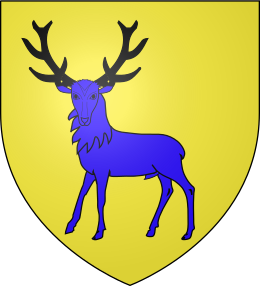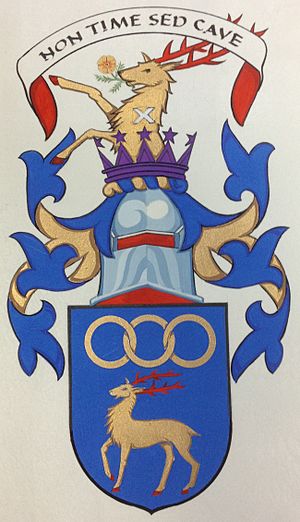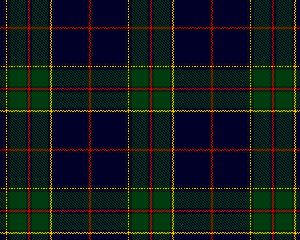Clan Strachan facts for kids
Quick facts for kids Clan Strachan |
|
|---|---|
| Strathaen | |
| Motto | Non Timeo Sed Caveo (I fear not, but am cautious) |
| War cry | Clachnaben! |
| Profile | |
| Region | Aberdeenshire |
| District | Strachan, Aberdeenshire |
 |
|
| Clan Strachan has no chief, and is an armigerous clan | |
| 6th Baronet of Thornton | |
| Last Chief | Sir Richard Strachan |
| Died | 3 February 1828 |
| Commander | Charles Robert Lund (Rob) Strachan |
Clan Strachan is a Scottish clan that comes from the area (called a barony) of Strachan in Aberdeenshire, Scotland. Today, the clan does not have a main leader, known as a chief. Because of this, it is called an Armigerous clan. This means the clan has a coat of arms but no official chief recognized by Scottish law.
In 2014, Clan Strachan held a special meeting called a Family Convention. This meeting was watched over by the Court of the Lord Lyon, which is Scotland's authority on heraldry and clans. At this meeting, everyone agreed that Rob Strachan should be recognized as the Clan's Commander.
Soon after, the Lord Lyon, Dr. Joseph Morrow, officially appointed Rob Strachan as Commander of Clan Strachan for five years. This appointment was extended for another five years in 2019, lasting until 2024.
The special shout or cheer for Clan Strachan is Clachnaben!
Contents
Is Clan Strachan a Highland or Lowland Clan?
Scotland has a natural dividing line called the Highland Boundary Fault. This line separates the mountainous Highlands from the flatter Lowlands. You can often tell where it is by how the land changes.
The village of Strachan is about 15 miles northwest of Stonehaven. It is very close to the Highland Boundary Fault, which means the area of Strachan is actually in the Highland Region.
In the past, the lands of Strachan were part of a larger area ruled by a powerful local leader called Máel Petair of Mearns. He was involved in the death of King Duncan II of Scotland in 1094. Later, these lands became part of the King's own property.
So, during medieval times, Clan Strachan was a "Lowland Family" living in the "Highland Region." This was not unusual. Other well-known clans like Gordon and Fraser were also in a similar situation.
History of Clan Strachan

Where the Clan Name Came From
The name Strachan comes from the place where the clan lived. It's a "local" or "territorial" name, meaning it tells you where someone came from. It doesn't automatically mean everyone with the name is related.
The village of Strachan is in the Grampian Highlands of Scotland, southwest of Aberdeen. The area around Strachan is quite large, stretching for about 20 miles.
Three Gaelic words combine to form the name STRACHAN:
- The Gaelic word "strath" means "broad valley."
- The main river in Strachan is the Waters of the Feugh. The word Feugh might come from an old Gaelic word for deer.
- The Gaelic word for 'river' is abhainn. In some parts of Scotland, this word is pronounced like "awn."
In early times, the name STRACHAN was pronounced with three syllables, like /strath-euch-an/. The 'ch' sound was like the 'ch' in the Scottish word "loch." This means the original meaning of STRACHAN was "Valley of the Deer River." The spelling "Strachan" as we know it today didn't appear until the 1600s.
Interestingly, the main symbol on Strachan coats of arms is a stag (a male deer). This is an example of canting arms, where the symbol on the shield hints at the name.
Today, there are two common ways to say the name:
- /stra-khan/ (with the 'ch' sound like in loch): This is more common in Scotland and England.
- /strawn/ or /struan/: This is more popular outside Scotland, especially among families who moved away before the 1850s.
How the Strachan Family Got Their Lands
Around 1189-1195, King William the Lion gave the lands of Strachan to William Gifford. This made Strachan a barony, meaning it was a special area with certain rights. The King also made it a "forest," which meant no one could cut trees or hunt there without permission.
It seems that the Strachan family took over the barony from William Gifford between 1202 and 1211. They likely got the land through marriage, as was common back then.
The Strachan family, like the Giffords, were not originally from the Scottish Highlands. They were of Anglo-Norman descent, meaning their ancestors came from England or Normandy (in France).
One early Strachan, Waltheof de Strachan, gave hunting and timber rights in part of the Strachan barony to a priory (a type of monastery) in 1230. This area was called Blarkerocch, which probably means "the moor field with the Cairn." This description matches a place in Strachan village where an ancient burial mound (cairn) was found.
The Strachan family also likely had connections to the de Quincy family through marriage. This connection might have linked them to the powerful Comyn family. In 1264, Ranulf de Strachan was made Sheriff of Banffshire, a role often passed down through families. This might support the idea that the Strachans were related to the Comyns.
The Wars of Scottish Independence
The Strachan family owned lands given by the King, so they supported the King of Scotland. In 1292, this was King John Balliol. When Robert the Bruce killed Red Comyn, the Comyn family became enemies of Bruce. The Strachans were likely related to the Comyns and supported them.
Bruce's forces probably burned down a wooden fort in Strachan, now called Castlehill of Strachan, around 1308. The Comyns and their supporters, including Clan Strachan, were defeated at the Battle of Inverurie (1308). After Bruce won the Battle of Bannockburn in 1314, the Strachans lost their lands. Robert the Bruce gave the lands of Strachan to Sir Alexander Fraser.
However, the Strachans eventually started to regain their standing. In 1346, Alexander Strachan and his son died fighting for Scotland at the Battle of Neville’s Cross in England. They fought alongside the Earl of Buchan under King David II, Robert the Bruce's son.
Around 1350, many families who had lost their lands under Robert the Bruce started to get them back. During this time, five new main branches of the Strachan family were formed: Knock, Glenkindie, Thornton, Lenturk, and a barony in Aberdeenshire. This suggests that the Strachans were once again seen as important and trustworthy.
17th-18th Century: Civil War and Divided Loyalties
In 1625, Sir Alexander Strachan of Thornton received a special title called a Baronet of Nova Scotia from King Charles I. This title later passed to Sir James Strachan.
Sir James sold his estate in 1683. He was also a minister who refused to pray for the new King William and Queen Mary, instead supporting the old King James II. He died in 1715.
His son, also named James, joined the Highland forces supporting King James II. He fought at the Battle of Killiecrankie in 1689, where he was killed. This shows how loyal the Strachans of Thornton were to the old royal family.
However, other Strachan family members had different loyalties. Alexander Strachan of Glenkindie was known as a "Great Covenanter," meaning he supported the government. His grandson, Sir Patrick, was even imprisoned by the Jacobites (supporters of King James II) in 1715.
By 1746, at the Battle of Culloden, most of the main Strachan families had died out. The only remaining line was the Strachans of Thornton, who were living in London. Clan Strachan was much smaller and less powerful by this time. Some Strachans did fight for the Jacobites at Culloden, and one, John Strachan, is listed among the dead.
Napoleonic Wars
In the 1800s, during the Napoleonic Wars, a famous Strachan emerged: Admiral Sir Richard Strachan. He was a direct descendant of the Strachans of Thornton. In 1805, his naval squadron fought and captured four French warships that had escaped from Lord Nelson's big victory at the Battle of Trafalgar. Sir Richard won this battle with very few losses for the British.
For his bravery, he was made a Knight of the Bath and given the freedom of the City of London. Sir Richard died in 1829 without any sons, so his title eventually became inactive.
Clan Strachan Today
The last official chief of Clan Strachan was Admiral Sir Richard John Strachan, who died in 1828. Since he had no male heir, the title of chief became "dormant" (inactive) in 1854.
As mentioned earlier, the Clan Strachan Society held a special meeting in 2014. They decided to recognize Rob Strachan as the new Commander for Clan Strachan. A Commander is a temporary leader who might become the permanent chief after a certain period, usually 10 years. This "waiting period" allows time for anyone else with a stronger claim to the chiefdom (like a direct descendant of a past chief) to come forward. Since no one has claimed the chiefship in over 186 years, it is expected that Rob Strachan will eventually become the recognized hereditary Chief of Clan Strachan.
In 2012, the Clan Strachan Society received its own Grant of Arms from the Lord Lyon. This means the Society is officially recognized and can use its own coat of arms. The Society helps manage the clan's affairs and supports the chief.
Here's what the Clan Strachan Society's Coat of Arms looks like:
- Azure, a hart trippant Or attired and ungulled Gules in chief three annulets conjoined in fess Or.
- "Crest issuant from a celestial crown Purpure a demi-hart rampant Or attired and ungulled Gules charged with a saltire Argent and in its mouth a California Poppy Proper."
Clan Castles
- Castlehill of Strachan: This was a timber fort in the village of Strachan. It was used from about 1250 until it was burned down by forces loyal to Robert the Bruce in 1308.
- Glenkindie House: Adam Strachan was given lands in Aberdeenshire around 1350. He also married Margaret Mar, who was related to the Earl of Mar. Because of this marriage, the Strachans of Glenkindie became important. They could even wear the Tribe of Mar tartan.
- House of Thornton: In 1348, Sir James Strachan of Monboddo married Agnete, who inherited the Barony of Thornton. This made the Strachans of Thornton, along with the Strachans of Glenkindie, the two main branches of the Strachan family. Thornton Castle is about 15 miles south of Strachan village.
- House of Carmyllie: Alexander de Strachan was given the barony of Carmylie in Forfarshire in 1347. He also received other lands.
- House of Lenturk: Sir John de Strachan was given the barony of Lenturk in Aberdeenshire around 1350. He later became Sheriff of Forfarshire in 1359.
- Barony of Aberdeenshire: Around 1347, King David II gave Donald de Strachan and his wife Annabel large areas of land in Forfarshire and a barony in Aberdeenshire.
- House of Knock: Thomas de Strachan received the lands of Knock in Kincardineshire.
It's likely that all these land grants and important marriages happened around the same time for a reason. Many historians believe that the Strachan family had supported King John Balliol, who was later overthrown by Robert the Bruce. After King David II (Bruce's son) was captured by the English in 1347, he might have decided to restore the Strachans' lands and standing, among others, to gain their support.
Clan Septs
Over time, as the Gaelic name was written down in English, it led to different spellings. These variations are called "septs." Some common spellings include Strachan (mostly Scottish), Straghan (mostly Irish), or Strahan (both Scottish and Irish), and Strawn (American).
Other recognized spellings and variations of Strachan include: Strachen, Strachn, Straughan, Strawhun, Straun, Strane, Stracon, Strahin, Strain, Strong, Strongman, Stronger, Strang, Stronge, Strang, Strange, Strangeman, Straughn, Strauchon, and Stranahan.
See also
- Armigerous clan
- Strachan Baronets
- Strachan (disambiguation)



